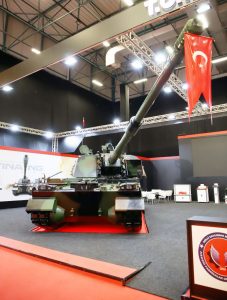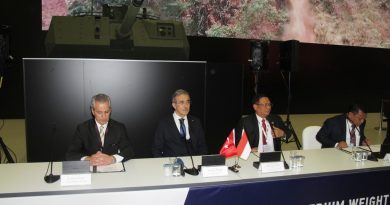
IDEF 19: T-155 Firtina SP Howitzer moves to New Generation
Actively used in border security and cross-border operations by the Turkish Land Forces, the T-155 self-propelled howitzer will increase its effectiveness thanks to a series of new subsystems, improvements taking into account feedbacks from the battlefield as well as recent technological developments.

The Firtina NG (for New generation) was exhibited at the Ministry of National Defense, General Directorate of Military Factories stand at IDEF. Looking from the outside, the main new feature is the addition of Aselsan’s SARP RCWS on top of the howitzer turret, on the rear left corner, which adds considerable self-defence capabilities to the Firtina. The problem given by the increased height was solved installing the SARP on a folding system that allows its rotation backwards, the RCWS being thus folded along the rear wall of the turret. However the major improvements are not visible at first sight. One of the comes again from Aselsan in the form of the new generation fire control system, which is interfaced with the fully automatic ammunition loading system. This picks up the ammunition from the magazine, which is of the chain type thus allowing to quickly reaching the type of round selected by the gunner, carrying it automatically to the gun breech. The new computer and the software developed following the NATO Artillery Ballistic Kernel allow increasing accuracy, also thanks to the propellant conditioning unit that keeps under control the charges temperature, feeding the data into the computer. The new loading system also allows a higher rate of fire, the initial three round being still fired in 15 seconds, however intense fire rate is increased of one round per minute, up to 7-8 rpm. With these modifications the Firtina NG is capable to carry out Multiple Round Simultaneous Impact missions, hitting the same target with three rounds at the same moment. The new inertial navigation system allows the Firtina NG to open fire within 30 seconds from reaching its position, carry out the 7-8 rounds fire mission in one minute, leaving its firing location within 30 seconds, avoiding enemy counterfire.
A key element in terms of safety is the adoption of an all-electric turret, avoiding the dangerous hydraulic piping. All metrics remain the same of the original Firtina, with two exceptions: the length is increased from 12 to 13.1 meters due to the presence of the RCWS, and weight increases from 47 to 48 tonnes. According to information the first phase of qualification firing trials have been completed.
Photos by Paolo Valpolini


